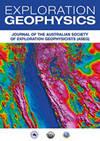评估经验推导的无侧限抗压强度(UCS)估计的不确定性以及对钻井应用的影响;库珀盆地的一个案例研究
IF 0.8
4区 地球科学
Q4 GEOCHEMISTRY & GEOPHYSICS
引用次数: 0
摘要
准确估计无侧限抗压强度(UCS)对于一系列地下应用至关重要,包括钻井进行地下流体提取或注入。然而,通过基于实验室的单轴和三轴测试来测量地下岩石样品的UCS既耗时又昂贵,而且可能受到个别样品差异的影响。纵波速度测井通常在含油气盆地中获得,通常使用经验推导的相关性来估计UCS。在这项研究中,我们分析了澳大利亚Cooper盆地43口井的纵波速度数据,并通过文献推导的纵波速度-UCS相关性,创建了Tirrawarra、Toolachee、Patchawarra、Murteree页岩和Epsilon地层的预期UCS的平均范围,并根据实验室确定的纵波速度测量值估计了UCS。然后将这两组由纵波速度推导的UCS估计与岩心样品实验室单轴测试的可用结果进行比较。我们的分析表明,纵波速度,以及随后从纵波电缆测井中得出的UCS估计,通常低于实验室分析样品的结果。这可能反映了在实验室UCS测试中选择坚固岩石的抽样偏差,或者由于井眼损伤和孔隙空间含量(空气或液体)从纵波测井得出的速度而降低了UCS的估计。然而,当使用已公布的经验速度-强度相关性时,实验室导出的纵波速度与来自Patchawarra、Murteree页岩和Epsilon地层的实验室导出的UCS数据基本一致。一个回顾性的案例研究展示了不同的UCS估计对Epsilon地层产生观察到的井眼突兀所需泥浆比重的影响。在钻井过程中,钻井液密度为9.7 ppg,裂缝与SHmax(117°N)方向成90度,平均宽度为51°。根据观测到的漏孔宽度,在9.7 ppg下,反向计算出的UCS为154 MPa。这一数值介于UCS单轴测试估计的171 MPa和实验室样品推导的平均纵波速度的145 MPa之间。仅基于p波对数推导的经验相关性对UCS的估计要低得多,在87.3和114.4 MPa之间变化。本文章由计算机程序翻译,如有差异,请以英文原文为准。
Evaluating uncertainty in empirically derived unconfined compressive strength (UCS) estimates and implications for drilling applications; a case study from the Cooper Basin
Accurate estimates of Unconfined Compressive Strength (UCS) are essential for a range of subsurface applications, including drilling wells for subsurface fluid extraction or injection. However, measuring UCS of subsurface rock samples through laboratory-based uniaxial and triaxial testing is time consuming, expensive, and potentially subject to individual sample variance. P-wave velocity logs are routinely obtained in petroleum basins and are commonly used to estimate UCS using empirically-derived correlations. In this study we analysed P-wave velocity data from 43 wells in the Cooper Basin, Australia and created mean ranges of expected UCS through the Tirrawarra, Toolachee, Patchawarra, Murteree Shale and Epsilon formations, using literature-derived P-wave velocity-UCS correlations, and also estimated UCS based on selected available laboratory-determined P-wave velocity measurements. These two suites of P-wave velocity-derived estimates of UCS are then compared to available results from laboratory uniaxial testing of core samples. Our analysis indicates that P-wave velocities, and subsequent derived estimates of UCS from P-wave wireline logs, are typically lower than those from laboratory-analysed samples. This may reflect a sampling bias towards the selection of strong rocks for laboratory UCS testing or lower estimates of UCS due to wellbore damage and pore space content (air or liquids) from P-wave log derived velocities. However, the laboratory-derived P-wave velocities generally agree with laboratory-derived UCS data from the Patchawarra, Murteree Shale and Epsilon formations when using published empirical velocity-strength correlations. A retrospective case study presents the impacts of different UCS estimates on mud weight required to produce observed borehole breakouts in the Epsilon Formation. Breakouts were observed 90 degrees to the orientation of SHmax (117° N) with a mean width of 51°, the breakouts were produced during drilling using a 9.7 ppg mud weight. The back-calculated estimate of UCS from the observed breakout widths at 9.7 ppg is 154 MPa. This sits between the UCS estimate of 171 MPa from uniaxial testing and 145 MPa from the mean of laboratory sample-derived P-wave velocities. Estimates of UCS from empirical correlations based solely on p-wave log-derived are far lower and vary between 87.3 and 114.4 MPa.
求助全文
通过发布文献求助,成功后即可免费获取论文全文。
去求助
来源期刊

Exploration Geophysics
地学-地球化学与地球物理
CiteScore
2.30
自引率
0.00%
发文量
33
审稿时长
>12 weeks
期刊介绍:
Exploration Geophysics is published on behalf of the Australian Society of Exploration Geophysicists (ASEG), Society of Exploration Geophysics of Japan (SEGJ), and Korean Society of Earth and Exploration Geophysicists (KSEG).
The journal presents significant case histories, advances in data interpretation, and theoretical developments resulting from original research in exploration and applied geophysics. Papers that may have implications for field practice in Australia, even if they report work from other continents, will be welcome. ´Exploration and applied geophysics´ will be interpreted broadly by the editors, so that geotechnical and environmental studies are by no means precluded.
Papers are expected to be of a high standard. Exploration Geophysics uses an international pool of reviewers drawn from industry and academic authorities as selected by the editorial panel.
The journal provides a common meeting ground for geophysicists active in either field studies or basic research.
 求助内容:
求助内容: 应助结果提醒方式:
应助结果提醒方式:


